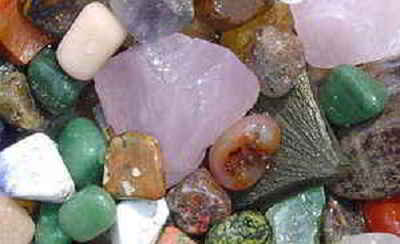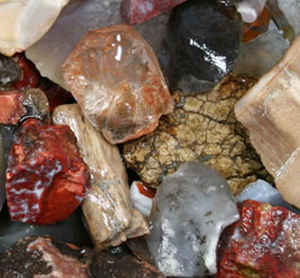
California Symbols
California State Rock & Lithologic Emblem
Serpentine

{(Mg, Fe)3Si2O5(OH)4}
Adopted on April 20, 1965
California has a greater number of minerals and a wider variety of rock types than does any other state. Serpentine, a shiny, green and blue rock found throughout California, was named the official State Rock on April 20, 1965, when Governor Edmond G. Brown signed Senate Bill No. 265 designating native gold as California's official state mineral and serpentine as California's official state rock.
It contains the state's principal deposits of chromite, magnesite, and cinnabar. California was the first state to designate a State Rock.
California State Rock & Lithologic Emblem: Serpentine

Serpentine rock is apple-green to black and is often mottled with light and dark colored areas. Its surfaces often have a shiny or wax-like appearance and a slightly soapy feel. Serpentine is usually fine-grained and compact but may be granular, platy, or fibrous in appearance. The term "serpentine" is commonly used by the general public to refer to the rock type that geologists call "serpentinite." Serpentine occurs in central and northern California - in the Coast Ranges, the Klamath Mountains, and in the Sierra Nevada foothills.
Serpentine rock is primarily composed of one or more of the three magnesium silicate minerals, "lizardite," "chrysotile," and "antigorite." Chrysotile often occurs as fibrous veinlets in serpentine. Chrysotile in fibrous form is the most common type of asbestos. Asbestos is a term applied to a group of silicate minerals that readily separates into thin, strong, and flexible fibers that are heat resistant. Lizardite and antigorite do not form asbestos fibers and instead are plate-like in form. Because serpentine often contains some asbestos, and exposure to asbestos fibers have potential human-health consequences, the Air Resources Board adopted regulations in 1990 restricting the use of this rock type as an unpaved road surfacing material. .

Serpentine is considered by geoscientists to be the metamorphosed remains of magnesium-rich igneous rocks, most commonly the rock peridotite, from the earth's mantle. The mantle is a thick layer of rock just below the earth's crust. One theory for serpentine formation and occurrence currently in favor with many geoscientists is that peridotite underlying oceanic crustal rocks have been metamorphosed to serpentine in subduction zones that existed at various times in California's past. A subduction zone is an area where ocean crust rocks run into and slide underneath the edge of a continent. Because serpentine has a much lower density than peridotite, it rose toward the surface along major regional thrust faults associated with the subduction zones.
Physical Characteristics of Serpentine
Serpentine is a major rock forming mineral and is found as a constituent in many metamorphic and weather igneous rocks. It often colors many of these rocks to a green color and most rocks that have a green color probably have serpentine in some amount.
Serpentinite is a rock composed of one or more serpentine group minerals. Minerals in this group are formed by serpentinization, a hydration and metamorphic transformation of ultramafic rock from the Earth's mantle. The mineral alteration is particularly important at the sea floor at tectonic plate boundaries.
- Color is olive green, yellow or golden, brown, or black.
- Luster is greasy, waxy or silky.
- Transparency crystals are translucent and masses are opaque.
- Crystal System is variable, see above.
- Crystal Habits: never in large individual crystals, usually compact masses or fibrous. Veins of viberous serpentine can be found inside of massive serpentine or other rocks.
- Cleavage the varieties of crysotile have none, in lizardite and antigorite it is good in one direction.
- Fracture is conchoidal in antigorite and lizardite and splintery in the crysotiles.
- Hardness is 3 - 4.5
- Specific Gravity is 2.2 - 2.6
- Streak white
- Associated Minerals include chromite, olivine, garnets, calcite, biotite and talc.
- Other Characteristics: serpentine in the rough has a silky feel to the touch and fibers are very flexible.
- Notable Occurances Val Antigorio, Italy; Russia; Rhodesia Switzerland; North Carolina, California, Rhode Island and Arizona, USA and Quebec, Canada.
- Best Field Indicators softness, color, silky feel and luster, asbestos if present and its flexibility
California Senate Bill No. 265
CHAPTER 89
An act to add Sections 425.1 and 425.2 to the Government Code, relating to state emblems.
[Approved by Governor April 20, 1965. Filed with Secretary of State April 20, 1965.]
The people of the State of California do enact as follows:
SECTION 1. Section 425.1 is added to the Government Code to read:
425.1. Native gold is the official State Mineral and mineralogic emblem.
SEC. 2. Section 425.2 is added to the Government Code to read:
425.2. Serpentine is the official State Rock and lithologic emblem.
California was the first state to adopt an official state mineral and an official state rock.
Chrysotile asbestos, occurring in serpentine, is a carcinogen listed by the EPA. Because of serpentine's association with asbestos and the demonstrated
health hazards of asbestos, there have been calls for stripping the serpentine of its title of official state rock.
California Law
California Law
The law designating Serpentine as the official California state rock and lithologic emblem is found in the California Government Code, specifically Title 1, Division 2, Chapter 2, Section 425.2.
CALIFORNIA GOVERNMENT CODE
TITLE 1. GENERAL
DIVISION 2. STATE SEAL, FLAG, AND EMBLEMS
CHAPTER 2. STATE FLAG AND EMBLEMS
SECTION 420-429.8
425.2. Serpentine is the official State Rock and lithologic emblem.
Minerals, & Gems

Gemstone, Minerals, Rocks






